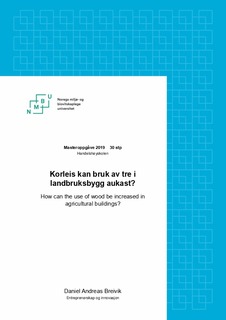| dc.contributor.advisor | Anders, Lunnan | |
| dc.contributor.author | Breivik, Daniel Andreas | |
| dc.coverage.spatial | Norway | nb_NO |
| dc.date.accessioned | 2020-01-27T15:35:24Z | |
| dc.date.available | 2020-01-27T15:35:24Z | |
| dc.date.issued | 2019 | |
| dc.identifier.uri | http://hdl.handle.net/11250/2638166 | |
| dc.description.abstract | Bakgrunn. Verda og landbruket må gjennomføre store utsleppskutt når det gjeld omstillinga til det «grøne skiftet». Tre er eit miljøvenleg bygningsmateriale som har gode positive effektar på dagens klimautfordringar. Tre bind karbon samstundes som at det er eit resirkulerbart materiale. Det er difor av interesse å undersøke korleis brukardriven innovasjon og næringsklynger vert brukt i arbeid for å gjere tre som byggjemateriale meir konkurransedyktig. Studien tek utgangspunkt i prosjektet «Landbruksbygg i tre», eit prosjekt i regi av Innovasjon Noreg (IN) som hadde eit fokus på å fremje meir bruk av tre ved å få fram nye innovative og rimelege byggjemåtar. Vidare bygg studiet på rapporten «Landbruksbygg i tre: Funksjonelle og klimasmarte bygninger» frå Norsk Landbruksrådgjeving (NLR) som viser ein statusoppdatering av kva innverknaden «Landbruksbygg i tre» har hatt sidan prosjektet vart avslutta i 2012.
Hensikt. Studiets formål har vore å undersøkje kva ulike aktørar tenkjer kan gjerast for at tre skal få større marknadsandelar innan landbruksbygg og om næringsklynger kan vere eit viktig verktøy for å nå målet. For å kunne gje eit svar har eg satt opp følgande problemstilling; Korleis kan bruk av tre i landbruksbygg aukast?
Metode. Dette er ein fenomenologisk studie og det vart brukt semistrukturerte intervju for innhenting av data. Det vart gjennomført ti intervju. Informantane var bønder, rådgjevar, produsentar / leverandørar og leiar av ei næringsklynge. Som ein del av arbeidet har eg delteke i ulike workshops og konferansar. Data derifrå har vorte brukt i triangulering saman med litteratur og intervjudata.
Funn og konklusjon. Funn frå studiet viser at det er forbetringspotensial knytta til brukarstyrt innovasjon i arbeidet med vidare utvikling for bruk av tre i landbruksbygg. Spørsmålet om næringsklynger stimulerer til bruk av tre i landbruksbygg, er det ut frå mine funn vanskeleg å komme med ein konklusjon på. Landbruket og byggebransjen arbeider med å få til utsleppskutt og difor er bruk av trematerialer ein viktig og vesentleg faktor i arbeidet framover. Dette bør det forskast vidare på. | nb_NO |
| dc.description.abstract | Background. The world and the national agricultural sector must reduce their climate footprint in the transition to a carbon neutral society. When we use wood in buildings it’s an eco-friendly material that not only binds carbon, it is also a material that can be recycled many times without hazardous emissions.
I find it interesting to make a study on how user driven innovation and innovation clusters can be used with the aim to make wooden materials more competitive compared to other building materials like for example steel and concrete.
The study builds on the project “Landbruksbygg i tre” (2010-2012) by Innovation Norway. The main goal of the project is to increase the awareness of wood as an innovative and competitive building material for Norwegian farmers. The study focuses on creating new solutions that are both functional and not too expensive for the customer compared to alternative material and solutions. was to make wood as building material more visible for Norwegian farmers, and they focused on creating new solutions that was both functional and not too expensive for the customer.
Purpose. The purpose of my study is to investigate what different people involved in building projects think can be done in order to increase the use of wooden materials in agricultural buildings. Further I explore if innovation clusters can be an important tool to reach this goal. In order to give an answer, I put forward the following research question; How can the use of wood be increased in agricultural buildings?
Method. My study is based on a phenomenological approach and I have used semi structured interviews in order to gather data. I have done ten interviews. The informants are farmers, adviser, producers and suppliers. Further, I have interviewed the manager of an innovation cluster. As part of my work I have participated in different workshops and attended conferences. Data gathered from these workshops and conferences have been used in a triangulation method together with data from literature and interviews.
Results and conclusion. My study shows improvement potentials related to a user driven innovation and the work for further development and implementation of more wooden materials in agricultural buildings. The other question is if Norwegian clusters stimulate the
4 use of wooden materials in agricultural buildings. I find it difficult to conclude that this is the case.
The agricultural and building sectors are working to reduce the emission of greenhouse gasses and looking for ways to achieve this. The use of wooden building materials can therefor be a very important action in the future work. Further research should be done in this area. | nb_NO |
| dc.language.iso | nno | nb_NO |
| dc.publisher | Norwegian University of Life Sciences, Ås | nb_NO |
| dc.rights | Attribution-NonCommercial-NoDerivatives 4.0 Internasjonal | * |
| dc.rights.uri | http://creativecommons.org/licenses/by-nc-nd/4.0/deed.no | * |
| dc.subject | Næringsklynger | nb_NO |
| dc.subject | Innovasjon | nb_NO |
| dc.title | Korleis kan bruk av tre i landbruksbygg aukast? | nb_NO |
| dc.title.alternative | How can the use of wood be increased in agricultural buildings? | nb_NO |
| dc.type | Master thesis | nb_NO |
| dc.source.pagenumber | 45 | nb_NO |
| dc.description.localcode | M-EI | nb_NO |

